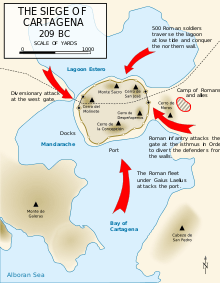Battle of Cartagena (209 BC)
| Battle of Cartagena | |||||||
|---|---|---|---|---|---|---|---|
| Part of the Second Punic War | |||||||
 | |||||||
| |||||||
| Belligerents | |||||||
|
|
| ||||||
| Commanders and leaders | |||||||
|
Scipio Africanus Gaius Laelius | Mago (POW) | ||||||
| Strength | |||||||
|
27,500 25,000 infantry 2,500 cavalry |
3,000 1,000 soldiers 2,000 armed civilians | ||||||
| Casualties and losses | |||||||
| Heavy[1] |
3,000 killed or captured Population massacred and enslaved | ||||||
The Battle of Cartagena 209 BC was a successful Roman assault on the Carthaginian stronghold New Carthage (Cartagena) in Iberia took place in late January to early February of 209 BC
Geography
New Carthage was a town situated on a peninsula - joined to the mainland to the east by a narrow isthmus. On the north side the town was protected by a large lagoon, which fed into a canal which protected the west side of the town. On the south side of the town, there was the Mediterranean Sea. As a result of this geography, New Carthage took advantage of the terrain to be very difficult to assault.
Background
Scipio sailed to Spain (Iberia) in middle 210 BC, and spent the early part of the winter organizing his army (the total force in Spain was approximately 30,000 men) and planning the assault on New Carthage.
Opposing him were the three Carthaginian generals (Hasdrubal Barca, Mago and Hasdrubal Gisco), who were on bad terms with each other, geographically scattered (Hasdrubal Barca in central Spain, Mago near Gibraltar and Hasdrubal near the mouth of the Tagus river), and at least 10 days away from New Carthage. The campaign was done in winter so they could recapture Saguntum and capture new Carthage with element of surprise and it was also a first in warfare history.
Livy mentions the city garrison as 1,000 Carthaginian soldiers under the command of Mago, who picked out a further 2,000 men from the city to defend the front gate and be ready for a sally, and an unspecified amount of townsmen to watch for sudden emergencies.[2][3]
Battle
Setting up camp across the isthmus with 27,500 men, Scipio isolated the town on the landward side, and with the Roman fleet (commanded by Gaius Laelius) blockading the town from the sea, the town was isolated from outside help. The Romans did not set up lines of circumvallation, intending to take the city by storm before help could arrive from the Carthaginians armies that were only 10 days away.[3][4]
The 2,000 Carthaginian armed citizens launched a sortie through the narrow east gate of the city.[3] Their purpose was to delay the progress of Roman siegeworks or assaults.[3] They got close to the Roman camp, where Scipio had been expecting such an attack.[3] Despite possessing every advantage over the Carthaginians in numbers, training, weapons and leadership, the Romans had to fight hard and long against the skilled militia.[3] Scipio fed in more maniples to the battle from his reserve and the Carthaginians broke and fled back to the city.[5]
Scipio launched an assault over the isthmus, while the fleet attacked from the southern side. A hail of Carthaginian missiles beat back every Roman assault with heavy casualties.[4] Scipio renewed the attack later in the day, with the addition of a party attacking through the lagoon on the northern side.[3] Aided by an expected squall (which drained some of the lagoon into the Mediterranean, reducing the depth of the lagoon so the Roman troops could easily cross it), the party managed to scale the undefended northern wall and attacked the rear of the defenders defending the isthmus. At the same time, the naval forces managed to penetrate the town from the south.[6]
Polybius gives a description of how Scipio Africanus stormed New Carthage:
| “ | ...directed [his soldiers], according to the Roman custom, against the people in the city, telling them to kill everyone they met and to spare no one, and not to start looting until they received the order. The purpose of this custom is to strike terror. Accordingly one can see in cities captured by the Romans not only humans who have been slaughtered, but even dogs sliced in two and the limbs of other animals cut off. On this occasion the amount of such slaughter was very great. [7] | ” |
Aftermath
With the fall of New Carthage, the Romans forced the Carthaginians to surrender the entire eastern coast of Spain, as well as capturing a large amount of military stores and the silver mines located nearby.
Footnotes
- ↑ Goldsworthy 2000, p. 275.
- ↑ Livy, 26.44
- 1 2 3 4 5 6 7 Goldsworthy 2000, p. 273.
- 1 2 Goldsworthy 2000, p. 274.
- ↑ Goldsworthy 2000, pp. 273–274.
- ↑ Livy 26.45
- ↑ Keegan, p. 265
References
- Goldsworthy, Adrian (2000). The Punic Wars. London: Cassell.
- Howard Hayes Scullard (2003-01-01). A History of the Roman World: 753 to 146 BC. Psychology Press. ISBN 978-0-415-30504-4.
- John Keegan (1993-09-16). A history of warfare. Vintage. ISBN 0-09-174527-6.
- Titus Livy, Ab urbe condita libri, Book XXVI, Chapters 41 through 51
